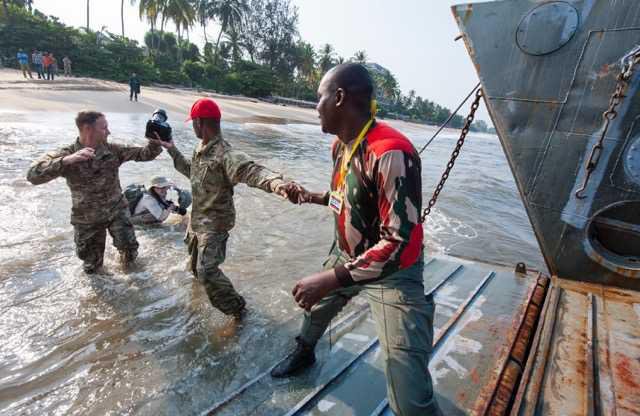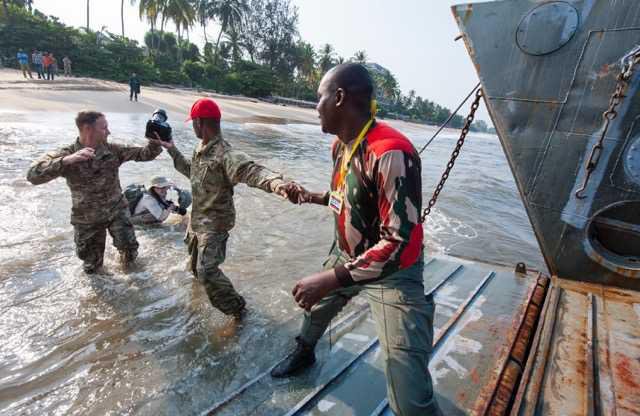POINTE DENIS, Gabon — Up to this point in my embed journey with both 3rd Infantry Division’s 1st Armored Brigade Combat Team in Poland and 2nd Infantry Brigade Combat Team in Gabon, I’ve had a few strenuous days. From running in the rain across a Polish live-fire range wearing a helmet and body armor while carrying camera equipment to traveling across two continents, this work has not been easy.
But Monday took the cake for physical fortitude.
Soldiers from 2nd BCT, 82nd Airborne Division were flying direct from Fort Bragg, North Carolina, to jump into Gabon during Central Accord 16 as part of their training as a global-response force. The jump demonstrated that the unit could fly from Fort Bragg and then be on the ground, secure an airfield and go on to its next mission within 18 hours, according to Maj. Loni Ayers, public affairs officer of 2nd BCT, 82nd Airborne.
The 2IBCT, 3rd ID public affairs team, other military journalists, and I set out early in the morning to get to the landing zone at Pointe Denis, which is across the Gabon Estuary from Libreville, the nation’s capital. After a few attempts, we eventually found the site where the landing craft was going to pick us up on a beach, along with other military personnel and supply vehicles.
While we waited on the beach, I opened a meal ready to eat military ration for breakfast, watching the waves break against the picturesque beach.
The landing craft finally arrived. It essentially looks like a larger version of what you see in the D-Day scene of “Saving Private Ryan,” when the soldiers storm Normandy Beach. It was going to be filled with a large supply truck, an ambulance and a pickup with some personal gear for attendees of the jump.
After the trucks were loaded, people started to walk up the ramp onto the landing craft. As the waves started to hit, the craft got loose from the shore, and more and more people began to run to get on the boat before they got too wet.
I was carrying my two cameras, my backpack and a helmet, and I had my phone in my leg pocket. You probably know where this is going.
When I attempted to get on the landing craft the first time, the water came up to about my knees, and I realized that my camera equipment was about to get wet if I went any further. After I relayed that to the people on the ramp who were telling me to keep going, Capt. Jarrod Morris, the public affairs officer for 2IBCT, 3rd ID, came forward to help hold one of my cameras while I tried again to get on.
On my second attempt, I ran toward the boat, which was now farther away from the shore, and the water now came up past my waist. And yes, my phone was submerged into the water. But I had to push on, or I was not going to make my ride. My shin also ran into the ramp as it picked up off the shore, leaving a great bruise to remind me of my “swim.”
But in the end, at least my camera gear made it, which is really what matters to a photojournalist.
The ride to Pointe Denis took about 45 minutes, and I sat on the roof of the pickup, watching the shore slowly come closer and figuring out how I was going to get dry again. Luckily, we are on the equator, so my pants eventually dried by the time of the jump, and my boots started to.
Once we landed on the white sandy beach of Pointe Denis, we walked into the landing zone, which was a massive field situated behind a few local houses and a beach resort that was closed for the day.
The group and I relaxed in the shade, attempting to dry out and snack on some MREs while we waited the five hours before the two C-17 planes were to arrive with the paratroopers.
The beaches on Pointe Denis are beautiful, calm and quiet, and the locals were very friendly to us. It was the most beautiful Army training location I had ever seen.
The paratroopers from Fort Bragg had been flying for around 15 hours before they finally were able to jump into Gabon. I went out on to the drop zone to see them jump overhead. The planes did several passes, and the soldiers, some of whom had never parachuted into another country before, then packed up their chutes and walked toward the rally point to check in and set up a simulated security perimeter.
Water was handed out to the airborne soldiers as the humidity kept rising that afternoon. Once the 110 paratroopers had completed their jump, our group had to head back to Libreville. This time, though, we were going to take a Gabonese Rigid Hull Inflatable Boat, which is essentially a speed boat.
Weighed down with several pounds of camera gear on top of my little life jacket, I will not lie that I was pretty nervous about what would happen if we hit a rough wave and I fell into the water with all the weight of that gear.
With knuckles white as I gripped the seat in front of me, we finally made it back to shore in half the time it took us to get to Pointe Denis. The boat was unable to fully land on the Libreville beach, so I had to run and swing over the front of the boat. But luckily, this time I only got my nearly dry boots wet. Again. Some were not as lucky, including one military journalist who fell in and was completely soaked head to toe.
It was one of the most physically demanding days I’ve ever had as a military reporter, but I really feel like I was shown a typical “just get through it” military experience, which is exactly why I choose to take embed opportunities. Even though I’ll never know what it’s like to be part of the military, I can at least witness a week in the life of soldiers who are sent to locations like Gabon, away from their families, to complete a mission asked of them by the government.
As for my phone, it sat in a bag of rice, where I had hoped some of the water would be absorbed, but it never recovered. Luckily, I’m due for an upgrade.
So for now, I’m just enjoying the quiet times I have without the distraction of my phone.
No, just kidding. I miss my phone.

